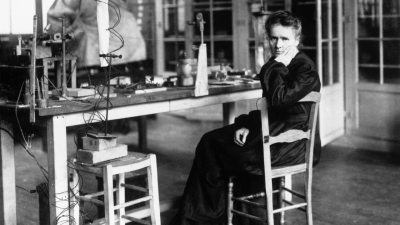
Marie Curie (November 7, 1867-July 4, 1934) was a French Polish physicist and chemist, famous for her pioneering research on radioactivity and the discovery of polonium and radium. She was the first woman to win a Nobel Prize, the only woman to win in two fields, and the only person to win in multiple sciences. She was also the first female professor at the University of Paris (La Sorbonne), and in 1995 became the first woman to be entombed on her own merits in the Pantheon in Paris]
In 1867, Maria Sklodowska was born in Warsaw, Poland. She was a bright and curious child who did well in school. At the time, the University of Warsaw refused students who were women. But that didn’t stop young Maria! Instead, she learned in secret. She went to informal classes held in ever-changing locations, called the “Floating University.”
In 1891, the woman the world would come to know as Marie Curie made her way to Paris. There, she enrolled at the Sorbonne, a university that didn’t discriminate. Over the next few years, she completed advanced degrees in physics and mathematics. She also met French physicist Pierre Curie. The two married in 1895.
Marie and Pierre worked closely over the next decade. Marie’s biggest discoveries came from studying uranium rays. She believed these rays came from the element’s atomic structure. Curie created the term “radioactivity” to name the phenomena she had observed. Her findings led to the field of atomic physics.
Together, the Curies studied the mineral pitchblende. Through their experiments, they discovered a new radioactive element. Marie named it polonium in honor of her native Poland. The two later also discovered the element radium.
In 1903, Marie and Pierre Curie were jointly awarded the Nobel Prize in physics. Marie was the first woman to receive a Nobel Prize. That same year, she also became the first woman to earn a Ph.D. from a French university. After Pierre’s death in 1906, Marie took over his teaching job at the Sorbonne. She was the first female professor at the institution.
In 1911, Curie became the first person—of any gender—to win a second Nobel Prize. This time, she was recognized for her work in the field of chemistry. Curie’s scientific reputation was known around the world. In fact, she was invited to attend the Solvay Congress in Physics. There, she joined other famous scientists of the day, including Albert Einstein.
After World War I began in 1914, Marie used her scientific knowledge to support France’s efforts in the war. She helped to develop the use of portable X-ray machines in the field. In fact, the medical vehicles that carried these machines became known as “Little Curies.”
Marie Curie never knew the toll her work would take on her health. She died in France in 1934 from advanced leukemia related to prolonged exposure to radiation. Today, Curie’s notebooks are still too radioactive to be safely handled. They are stored in lead-lined boxes in France.
Marie Curie left a great legacy of accomplishment and scientific curiosity. Her daughter, Irène Joliot-Curie, followed in her footsteps. Joliot-Curie received the Nobel Prize in chemistry in 1935, one year after her mother’s death.
In 1995, Marie and Pierre Curie’s remains were placed in the Panthéon in Paris. This is known as the final resting place of France’s most distinguished citizens. Marie Curie was the first woman to be interred there on her own merit.
Credit : Wonder Opolis
Picture Credit : Google




